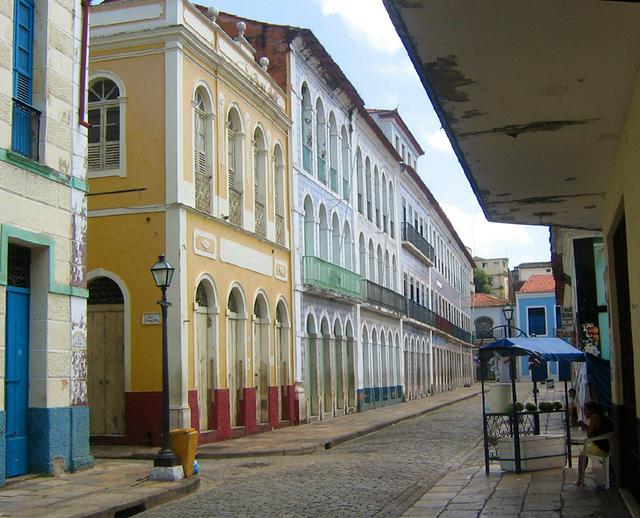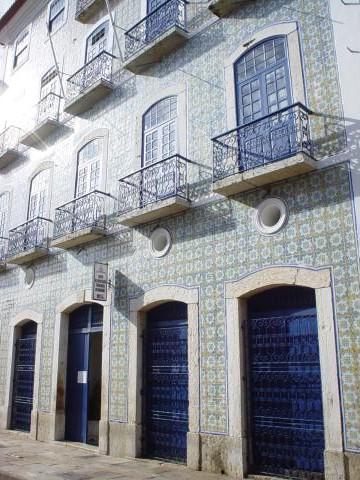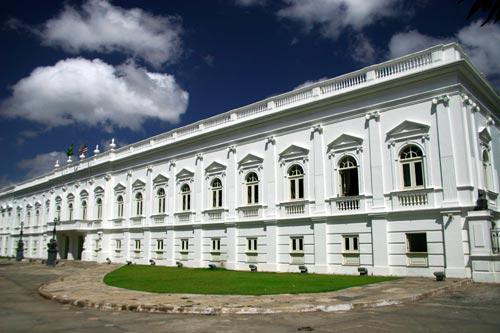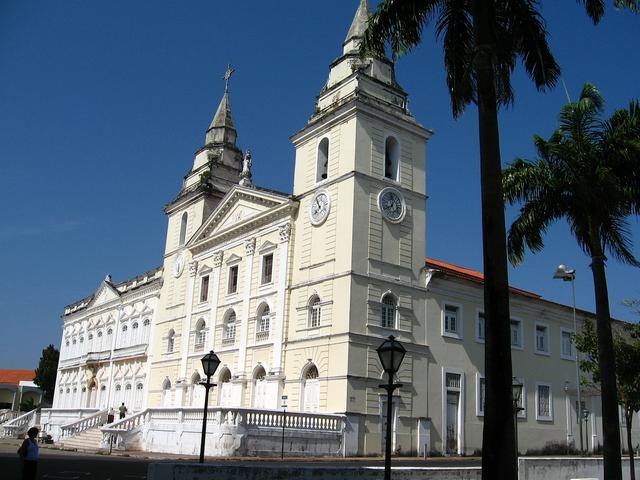
São Luís is the capital of the Brazilian state of Maranhão. It's known for its colonial Historical Center, a UNESCO World Heritage Site, and is a common stopover for visiting the stunning Lençóis Maranhenses.
 São Luís's people, history and culture is marked by a distinctive fusion of Portuguese, indigenous Brazilian and African elements, such as its highly popular local version of the Bumba meu boi festival, happening yearly in June and July. The reggae music from the Caribbean is also immensely popular in São Luís, often referred to as the "Brazilian Jamaica".
São Luís's people, history and culture is marked by a distinctive fusion of Portuguese, indigenous Brazilian and African elements, such as its highly popular local version of the Bumba meu boi festival, happening yearly in June and July. The reggae music from the Caribbean is also immensely popular in São Luís, often referred to as the "Brazilian Jamaica".
São Luís was founded by the French invaders in 1612, and taken over by the Portuguese in 1615. It was subsequently conquered by Dutch invaders in 1641, and finally, re-taken over for good by the Portuguese in 1644. The city prospered between the 17th and 19th centuries by means of export-oriented plantations (especially cotton) and slave trade. The city's Historical Center, a World heritage site, with buildings with beautiful azulejo (tiles) walls and the cobblestone streets, has been erected mostly during this era.
In the end of the 19th century, however, São Luís suffered from economic collapse due to the decline of cotton exportations. Only after the 1960s the city started to recover by means of government investments and iron exports, via the Vale do Rio Doce mining company. Tourism has also become an important part of economy, especially during the Bumba meu boi festivities, but tourism development is still hampered by several factors, including subpar infrastructure, lack of lingual proficiency of tourism workers, difficulties on preservation of historical heritage, and urban violence.
For a visitor, there are two main areas of interest in São Luís:
- The city's Historical Center, located by the sea, just south of the Anil river, which is also the city's cultural heart and center of popular shopping
- The area around the Lagoa da Jansen (Jansen's lagoon), containing the city's urban beaches and most modern, affluent neighborhoods (like Ponta do Farol, Ponta da Areia and Jardim Renascença), including more upscale shopping and nightlife
The city's Historical Center, located by the sea, just south of the Anil river, which is also the city's cultural heart and center of popular shopping
The area around the Lagoa da Jansen (Jansen's lagoon), containing the city's urban beaches and most modern, affluent neighborhoods (like Ponta do Farol, Ponta da Areia and Jardim Renascença), including more upscale shopping and nightlife

 São Luís's Historical Center is certainly the city's main attraction. Founded in 1612 by the French, it has been gradually expanded until the XX century, incorporating mostly Portuguese architecture adapted to the local climate. The azulejo titles, with insulating properties, are an example of adaption to tropical climate. The place is a testimony to the city's past wealth as the home of the cotton aristocrats, althoughmany buildings are in sorrow shape.
São Luís's Historical Center is certainly the city's main attraction. Founded in 1612 by the French, it has been gradually expanded until the XX century, incorporating mostly Portuguese architecture adapted to the local climate. The azulejo titles, with insulating properties, are an example of adaption to tropical climate. The place is a testimony to the city's past wealth as the home of the cotton aristocrats, althoughmany buildings are in sorrow shape.
- Igreja da Sé - Av. Pedro II - Centro.
- Palácio dos Leões (Lions Palace - seat of the Governor) - Av. Pedro II - Centro.
- Museu Histórico e Artístico do Maranhão - Rua do Sol, Centro.
- Convento das Mercês
- Igreja do Desterro
- Casa de Nhozinho - Rua Portugal, Centro
- Fonte do Ribeirão (Stream's Fountain)- Rua do Ribeirão, Centro.
- Fonte das Pedras (Stones' Fountain)- Rua Antônio Rayol, Centro, close to Mercado Central.
- Teatro Arthur Azevedo - Second oldest in Brazil but very modern inside - Rua do Sol, Centro
- Centro de Cultura Popular Domingos Vieira Filho
- Solar São Luís - Considered the biggest azulejo-clad building in Brazil (3 floors), built in the late 1800s. - Rua do Egito, Centro.
- Museu de Arte Sacra(Sacred Art Museum) - The collection belongs to Arquidiocese de São Luís, composed by pieces made in the 18th and 19th centuries, featuring the Mannerist, Rococo, Baroque and Neoclassic styles. - Rua do Sol, Centro.
- Remédios Church and Praça Gonçalves Dias - Built in 1719 on Gothic style, stands on Gonçalves Dias square, a beautiful vision. Largo dos Amores, Centro.
- Cafuá das Mercês - Rua Jacinto Maia, Centro
Igreja da Sé - Av. Pedro II - Centro.
Palácio dos Leões (Lions Palace - seat of the Governor) - Av. Pedro II - Centro.
Museu Histórico e Artístico do Maranhão - Rua do Sol, Centro.
Convento das Mercês
Igreja do Desterro
Casa de Nhozinho - Rua Portugal, Centro
Fonte do Ribeirão (Stream's Fountain)- Rua do Ribeirão, Centro.
Fonte das Pedras (Stones' Fountain)- Rua Antônio Rayol, Centro, close to Mercado Central.
Teatro Arthur Azevedo - Second oldest in Brazil but very modern inside - Rua do Sol, Centro
Centro de Cultura Popular Domingos Vieira Filho
Solar São Luís - Considered the biggest azulejo-clad building in Brazil (3 floors), built in the late 1800s. - Rua do Egito, Centro.
Museu de Arte Sacra(Sacred Art Museum) - The collection belongs to Arquidiocese de São Luís, composed by pieces made in the 18th and 19th centuries, featuring the Mannerist, Rococo, Baroque and Neoclassic styles. - Rua do Sol, Centro.
Remédios Church and Praça Gonçalves Dias - Built in 1719 on Gothic style, stands on Gonçalves Dias square, a beautiful vision. Largo dos Amores, Centro.
Cafuá das Mercês - Rua Jacinto Maia, Centro
São Luís' urban beaches do not match the beauty of those found in other Northeastern capital cities, such as Maceió or Natal, neither are known for their cleanness. However, they are a still a nice place to experience Brazilian urban beach life. The city's beaches suffer from an enormous tidal variation - the sea reportedly recedes close to 1 km on some spots at low tide, and at high tide there is no dry sand left
- Ponta d'Areia, R. do Forte s/n. São Luís' westmost and most popular beach, not far from the city center, but also probably the most polluted and sometimes overcrowded. There are several restaurants and reggae bars around the beach.
- Calhau, Av. Ulisses Guimarães s/n. Reputedly the city's best beach, it has calm waters and good infrastructure of kiosks and restaurants.
- Olho d'Água. Located a bit further east than Calhau, it's a bit less crowded but still has considerable infrastructure.
Ponta d'Areia, R. do Forte s/n. São Luís' westmost and most popular beach, not far from the city center, but also probably the most polluted and sometimes overcrowded. There are several restaurants and reggae bars around the beach.
Calhau, Av. Ulisses Guimarães s/n. Reputedly the city's best beach, it has calm waters and good infrastructure of kiosks and restaurants.
Olho d'Água. Located a bit further east than Calhau, it's a bit less crowded but still has considerable infrastructure.
- Bumba-meu-boi - From 13 to 30 June - This beautiful folklore manifestation of Iberian origin is one of the highlights of the city's culture. It has been kept alive by the black people of São Luis and is performed by groups in costumes, telling a tale of a certain Bull through music, dance and theater throughout the city.
There is an art cinema in the Old Town, with a mix of Brazilian and weird imports.
The largest and most modern movie theatre, with 10 showrooms, is at the São Luís Shopping, mostly showing Hollywood fare.
Bumba-meu-boi - From 13 to 30 June - This beautiful folklore manifestation of Iberian origin is one of the highlights of the city's culture. It has been kept alive by the black people of São Luis and is performed by groups in costumes, telling a tale of a certain Bull through music, dance and theater throughout the city.
There are three malls in the city with one of them being in the historic part of town. There are numerous shops that sell souvenirs. The city center´s main pedestrian mall is Rua Grande, which has most shops but hardware and foodstuffs.
Local dishes include Peixada(fish) and shrimp pie, and Arroz de cuxá -rice with herbs.
In Old Town:
- La Pizzeria. Real Italian style, probably the best in the state Pizza for 2 R$17-29.
- Toca da Amizade, Rua João Victal, Old Town. Serves late lunch. Set meals R$5-10.
- Dom Francisco, Old Town. Lunch R$20 per kilo, dinner a la carte.
La Pizzeria. Real Italian style, probably the best in the state Pizza for 2 R$17-29.
Toca da Amizade, Rua João Victal, Old Town. Serves late lunch. Set meals R$5-10.
Dom Francisco, Old Town. Lunch R$20 per kilo, dinner a la carte.
Maranhão has its own version of the guaraná soft drink, called Jesus (nothing religious, it was the inventor´s name). It is pink and rather sweeter than the others. Many small bars around Old Town, but quite dead on Sundays, when most action goes along the beaches. Another area is along the Lagoa da Jansen, near the beach Ponta d'Areia. A third is on the beach of Calhau. Night buses go past these areas every half hour on weekends.
- Kabão. Big open air
- Bar do Porto. Reggea spot by the boat terminal
- Bar do Nelson. Weekends. Bar come club, mostly reggea, some live. Drinking on the street outside. Entry R$10.
- Pirata, Avenida Litoranea, Calhau. Weekends. As big as it gets in this city. Forró. Also quite a party on the pavement outside. Entry R$10.
Kabão. Big open air
Bar do Porto. Reggea spot by the boat terminal
Bar do Nelson. Weekends. Bar come club, mostly reggea, some live. Drinking on the street outside. Entry R$10.
Pirata, Avenida Litoranea, Calhau. Weekends. As big as it gets in this city. Forró. Also quite a party on the pavement outside. Entry R$10.
São Luís is safe enough by Brazilian standards, although roaming the empty streets of the Historical Center at night should be avoided. As with anywhere else in South America, not displaying expensive possessions (such as professional cameras, smartphones and stacks of cash) avoids trouble.
- Laundry at Lavamatic, upper end of Rua Ribeirão, R$ 9/kg, next day if you are lucky.
Laundry at Lavamatic, upper end of Rua Ribeirão, R$ 9/kg, next day if you are lucky.
- Alcântara - Reached by an approximately hour long boat ride from São Luis. Timetables are not entirely stable as they depend somewhat on tides, but mostly around 7 and 9AM there should be a boat, R$10, with return in the late afternoon. Doublecheck at ticket office the day before.
- Lençóis Maranhenses through Barreirinhas
